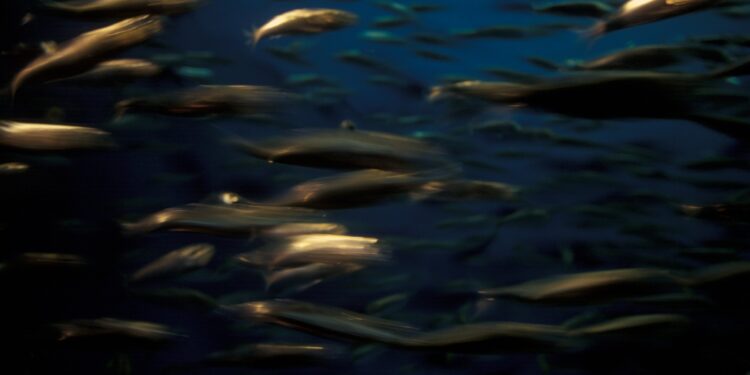Credit: UNSPLASH / CC0 public domain
Researchers led by the Marine Research Institute in Norway report a gap towards the 800 km pole in the Norwegian herring Frai land (Herring NSS) following a collective migratory memory loss in older fish due to selective age fishing. The results indicate potential disturbances on coastal food networks and have challenges for fisheries management.
Training, the process by which migration routes are transferred from experienced apparitions to recruits by social learning, is an integral part of the migration culture of school populations. Previous research has indicated that selective fishing targeting older fish can disrupt cultural transmission, fragmenting the established migration routes.
Historically, the Hareng NSS has migrated up to 1,300 km south of the wintering areas in North Northern waters to appear along the west coast in Møre, a road proposed to balance the energy costs of long -distance swimming with the advantages of improving larval survival in southern waters.
In the study, “Herring generated the pole after the collective memory loss induced by fishing”, published in NatureThe researchers carried out an integrative observation analysis combining recordings of peaches, acoustic scientific surveys and marking experiences to assess whether social learning has disrupted the geography of the Frai.
Data from 1995 to 2024 were obtained from Norwegian, Icelandic and fed fisheries, representing approximately 80% of the total herring, as indicated in the International Council for the exploration of the seas.
The acoustic scientific surveys carried out annually from 2018 to 2024 annually provided quantitative data on migration tracks, food grounds and frai areas. Investigations were carried out during peak migration periods to capture the variations in the spatial distribution and the composition of the school.
Between 2016 and 2023, 202,155 Harengs were labeled in Norwegian fjords in the North using passive integrated (PIT) transponder tags. TAG reuptake data, collected in processing installations equipped with RFID antennas, have been referenced with acoustic survey data to follow the migration routes and Frai locations.
Herring migration strategies in a dynamic environment. Credit: Nature (2025). DOI: 10.1038 / S41586-025-08983-3
The analysis of fishing recordings, surveys on acoustic transactions and marking data indicated a substantial migration to the north, the Frai activity center moving about 800 km from Møre to Lofoten.
The data on the acoustic lifting of the transfer and the marking records revealed that the 2016 cohort had established new Frai roads in northern waters, diverging from historical migration models associated with older age classes. The 2016 cohort has circumvented the traditional south-south route to Møre, initiating the North road to Lofoten, a model which has become prominent from 2021.
Surveys of the Frai season have confirmed a 68% drop in the biomass of older mats, from around 4.0 million tonnes in 2019 to 1.3 million metric tonnes in 2023. During these investigations, the 2016 cohort maintained a sufficient biomass to maintain a Frai activity, representing more than 50% of the Fraying population by 2021.
The acoustic transfer data indicated a marked reduction in spatial overlap between recruits and older fish during periods of Frai, limiting the possibilities of cultural transmission of migratory routes.
The reuptake data of marked individuals have confirmed that subsequent cohorts have gradually adopted the newly established northern migration route, strengthening the change observed in the geography of the Frai.
The results suggest that the gap towards the pole in the Frai terrains of herring NSS can lead to long -term alterations of the migratory models trained by the loss of social learning, a consequence of reductions in interactions between the elderly facons and recruits.
The change of 800 km, which has become evident while the 2016 cohort reached digital domination in 2021, represents a significant gap of the historic migratory routes with a wide range of implications for the availability of prey in the flows of food canvas and nutrients in the waters of the South.
Now that a new migratory scheme has appeared, reinforced by collective migratory memory, the restoration of historical models may be impossible.
More information:
Arril Slotte et al, Herring engendered towards pole after the collective memory loss induced by fishing, Nature (2025). DOI: 10.1038 / S41586-025-08983-3
© 2025 Science X Network
Quote: Collective memory loss in herring leads to a change of 800 km in the fields of Frai (2025, May 13) recovered on May 13, 2025 from
This document is subject to copyright. In addition to any fair program for private or research purposes, no part can be reproduced without written authorization. The content is provided only for information purposes.



